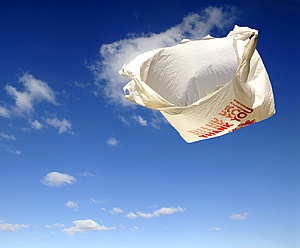
© iStockphoto.com/Spiderstock
Plastic bags have become an integral part of our daily lives, used for everything from grocery shopping to product packaging. The massive production of plastic bags, however, consumes vast quantities of non-renewable resources, including crude oil and natural gas. Replacing conventional plastics with bioplastics—plastics derived from renewable biomass such as vegetable starch—is one way to reduce our reliance on fossil fuels, but the environmental benefits and drawbacks of taking such a step have been unclear. Hsien Hui Khoo at the A*STAR Institute of Chemical and Engineering Sciences and co-workers have now conducted a life cycle assessment (LCA) to investigate whether the use of bioplastic bags is indeed good for the environment.
LCA is a technique used for analyzing the environmental impacts associated with all stages of a manufacturing process, and involves compiling an inventory of the energy and resources consumed and emissions and waste generated in the production of a particular product. The researchers used LCA in their study to compare the benefits of using polyhydroxyalkanoate (PHA) bags imported from the USA with those of using polyethylene bags produced locally in Singapore.
Polyethylene is currently the most widely used material for making plastic bags. The production of polyethylene bags requires the extraction and refining of fossil fuels, the conversion of fossil fuels into polyethylene, and the extrusion of polyethylene into plastic bags. The researchers estimate that 1.22 kg of crude oil, 0.4 kg of natural gas and 48 megajoules of energy are needed to make 1 kg of polyethylene bags.
PHA, on the other hand, is a bioplastic made from cornstarch. The production of PHA bags involves corn cultivation, harvesting, wet milling and fermentation. The researchers estimate that 4.86 kg of corn and 81 megajoules of energy are needed to produce 1 kg of PHA bags. To their surprise, Khoo and his team found that the energy consumed in the production of PHA bags is 69% higher than that for polyethylene bags.
Although corn growing can help offset carbon emissions via photosynthesis, the researchers found that PHA bag production requires higher energy input during production compared to polyethylene bag production. Therefore, PHA bags can be considered to be environmentally friendly only if the entire production process is performed using renewable energy.
The researchers caution that before bio-based materials can be regarded as sustainable alternatives to conventional plastics, a few challenges have to be overcome. “The main issue lies in reducing the energy demands of the conversion of biomass into plastic-like properties,” says Khoo.
The A*STAR-affiliated researchers contributing to this research are from the Institute of Chemical and Engineering Sciences.



